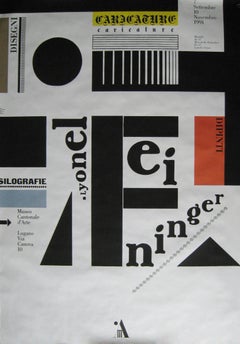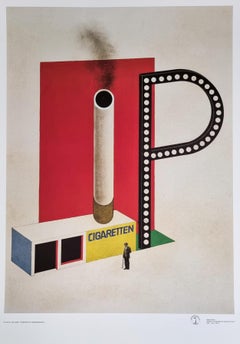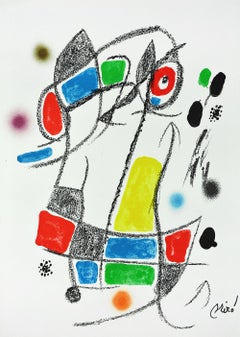Bruno Monzuzzi Art
to
2
2
2
1
1
Oskar Schlemmer/Igor Stravinsky's "Les Noces"
By Bruno Monzuzzi
Located in New York, NY
Oskar Schlemmer/Igor Stravinsky's Les Noces, 1988. Color
Lithograph. 35.5 x 50 inches (90 x 127 cm)
Monguzzi studied in Geneva and London, spent part of his early career in at the studio of Antonio Boggeri, in Milan. The inspiration of the experimental and visually-daring work of the avant garde designers Herbert Bayer, El Lissitsky, Jan Tschichold, Piet Zwart, Paul Schuitema, Ladislav Sutnar...
Category
1980s Abstract Bruno Monzuzzi Art
Materials
Lithograph
Florence Henri
By Bruno Monzuzzi
Located in New York, NY
Ritratti al Bauhaus. Photo-offset poster.
Museo cantonale d'arte Lugano
Year: 1991.
Monguzzi studied in Geneva and London, spent part of his early career in at the studio of Antonio Boggeri, in Milan. The inspiration of the experimental and visually-daring work of the avant garde designers Herbert Bayer, El Lissitsky, Jan Tschichold, Piet Zwart, Paul Schuitema, Ladislav Sutnar...
Category
1990s Bauhaus Bruno Monzuzzi Art
Materials
Offset
Related Items
Sale and Marketing Kiosk for P Cigarettes (Bauhaus) (20% OFF + Free Shipping)
By Herbert Bayer
Located in Kansas City, MO
Herbert Bayer
Sale and Marketing Kiosk for P Cigarettes (Verkauf- und Werbekiosk, Zigarettenmarke P ), 1924
Offset Lithograph
Year: 1994
Size: 33.2 × 23.2 inches
Publisher: Bauhaus A...
Category
1920s Bauhaus Bruno Monzuzzi Art
Materials
Lithograph
Joan Miró - MARAVILLAS CON VARIACIONES... Lithograph Contemporary Art Abstract
By Joan Miró
Located in Madrid, Madrid
Joan Miró - Maravillas con variaciones acrósticas en el jardín de Miró I
Date of creation: 1975
Medium: Lithograph
Media: Gvarro paper
Edition: 1500
Size: 49,5 x 35,5 cm
Condition: I...
Category
1970s Abstract Bruno Monzuzzi Art
Materials
Lithograph
Things to Come tray
By Herbert Bayer
Located in New York, NY
Herbert Bayer
Things to Come tray, 2018
Porcelain dish with metallic gold edge and silkscreened image
Limited edition of an unknown quantity, originally distributed by the Museum of Modern Art, before it sold out.
Measurements:
Box:
5.5 x 5.5 inches
Tray:
5 x 5 inches
Provenance:
Originally distributed by the Museum of Modern Art, before it sold out
Manufacturer:
Galison Publishing LLC and The Museum of Modern Art
Herbert Bayer biography:
Artistic polymath Herbert Bayer was one of the Bauhaus’s most influential students, teachers, and proponents, advocating the integration of all arts throughout his career. Bayer began his studies as an architect in 1919 in Darmstadt. From 1921 to 1923 he attended the Bauhaus in Weimar, studying mural painting with Vasily Kandinsky and typography, creating the Universal alphabet, a typeface consisting of only lowercase letters that would become the signature font of the Bauhaus. Bayer returned to the Bauhaus from 1925 to 1928 (moving in 1926 to Dessau, its second location), working as a teacher of advertising, design, and typography, integrating photographs into graphic compositions.
He began making his own photographs in 1928, after leaving the Bauhaus; however, in his years as a teacher the school was a fertile ground for the New Vision photography passionately promoted by his close colleague László Moholy-Nagy, Moholy-Nagy’s students, and his Bauhaus publication Malerei, Photographie, Film (Painting, photography, film). Most of Bayer’s photographs come from the decade 1928–38, when he was based in Berlin working as a commercial artist. They represent his broad approach to art, including graphic views of architecture and carefully crafted montages.
In 1938 Bayer emigrated to the United States with an invitation from Alfred H. Barr, Jr., founding director of The Museum of Modern Art, to apply his theories of display to the installation of the exhibition Bauhaus: 1919–28 (1938) at MoMA. Bayer developed this role through close collaboration with Edward Steichen, head of the young Department of Photography, designing the show Road to Victory (1942), which would set the course for Steichen’s influential approach to photography exhibition. Bayer remained in America working as a graphic designer for the remainder of his career.
-Courtesy of MOMA
More about Herbert Bayer:
Herbert Bayer (1900-1985) was born in Austria, where he entered into an apprenticeship under the architect and designer, Georg Smidthammer, with whom Bayer learned drawing, painting, and architectural drafting, inspired by nature and without formal knowledge of art history. In 1920, Bayer discovered the theoretical writings of the artist Vassily Kandinsky, as well as Walter Gropius’ 1919 Bauhaus manifesto, in which Gropius declared the necessity for a return to crafts, in which were found true creativity and inspiration. Bayer traveled to Weimar to meet Gropius in October of 1921 and was immediately accepted into the Bauhaus. There, he was deeply influenced by the instruction of Kandinsky, Johannes Itten and Paul Klee.
In 1928 Bayer moved to Berlin together with several members of the Bauhaus staff including Gropius, Moholy-Nagy and Marcel Breuer. He found work as a freelance graphic designer, particularly with German Vogue, under its art director Agha. When the latter returned to Paris, Bayer joined the staff full time, and also worked increasingly with Dorland, the magazine's principle advertising agency. It was in the period from 1928 to his emigration to America in 1938 that he developed his unique vision as an artist, combining a strongly modernist aesthetic sense with a rare ability to convey meaning clearly and directly. This seamless combination of art, craft and design mark Bayer as true prophet of Bauhaus theories.
Bayer followed Gropius to America in 1938, and set his breadth of skills to work later that year in designing the landmark Bauhaus 1918-1928 exhibition at the Museum of Modern Art. Bayer flourished in New York as a designer and architect, but it was his meeting with the industrialist Walter Paepcke in 1946 that allowed him to harness his concepts of 'total design' to the postwar boom. Paepcke was developing Aspen as a cultural and intellectual destination, and found in Bayer the perfect collaborator. Bayer was designer, educator and indeed architect for Paepcke's Aspen Institute...
Category
2010s Bauhaus Bruno Monzuzzi Art
Materials
Metal
Toward Eternity (2005-2006) Offset print Limited Edition by Aya Takano
By Aya Takano
Located in Hong Kong, HK
Toward Eternity (2005-2006). Offset print by Aya Takano
Offset print, numbered and signed by the artist
66.5 × 52.0 cm
(26⅛ × 20½ in.)
Edition 145/300
Category
Early 2000s Pop Art Bruno Monzuzzi Art
Materials
Offset
Blue Composition by Andre Lanskoy
By André Lanskoy
Located in New York, NY
This lithograph was printed in 1965 at the Atelier Mourlot in Paris. It is signed, and numbered from an edition of 150. A major theme running through Lanskoy's work is the interactio...
Category
1960s Abstract Expressionist Bruno Monzuzzi Art
Materials
Lithograph
Joan Miró - MARAVILLAS CON VARIACIONES... Lithograph Contemporary Art Abstract
By Joan Miró
Located in Madrid, Madrid
Joan Miró - Maravillas con variaciones acrósticas en el jardín de Miró IX
Date of creation: 1975
Medium: Lithograph
Media: Gvarro paper
Edition: 1500
Size: 49,5 x 71 cm
Observations:...
Category
1970s Abstract Bruno Monzuzzi Art
Materials
Lithograph
'Varietesoubrette, Schwalbennest' also Dancer — 1920s German Expressionism
Located in Myrtle Beach, SC
Martel Schwichtenberg (1896-1945), 'Varietésoubrette, Schwalbennest (Variety Soubrette, Swallow’s Nest), drypoint, 1922. Signed in pencil. A fine, richly-inked impression; the full s...
Category
1920s Bauhaus Bruno Monzuzzi Art
Materials
Drypoint
Derriere le Miroir Cover - Vintage Lithograph by Alexander Calder - 1968
By Alexander Calder
Located in Roma, IT
Derriere le Miroir Cover is an original artwork realized by Alexander Calder in 1968.
Original mixed colored lithograph.
The artwork was th...
Category
1960s Abstract Bruno Monzuzzi Art
Materials
Lithograph
H 14.97 in W 11.03 in D 0.04 in
'Little Locomotive' – Artist's Personal Letterhead, Bauhaus Modernism
By Lyonel Feininger
Located in Myrtle Beach, SC
Lyonel Feininger, 'Little Locomotive (Kleine Lokomotive)', woodcut, 1936, one of a small but unknown number of letterhead proofs; Prasse W158. Annotated 'W 158' (Feininger catalogue number) and '1936' in pencil, in the bottom right sheet corner.
A fine impression, on cream, laid letterhead stock; hinge remains on the left and right top sheet edges, verso, in excellent condition. Very scarce.
Image size 2 1/4 x 3 5/16 inches; sheet size 10 x 7 inches. Archivally sleeved, unmatted.
Exhibited: 'Lyonel Feininer, Woodcuts Used As Letterheads'; Associated American Artists; Feb 4 - March 2, 1974; New York, NY.
Collections: Cleveland Museum of Art, Museum of Modern Art, Staatliche Museen zu Berlin (East Berlin KK).
ABOUT THE ARTIST
Lyonel Feininger (1871-1956) was born in New York City into a musical family—his father was a violinist and composer, his mother was a singer and pianist. He studied violin with his father, and by the age of 12, he was performing in public, but he also drew incessantly, most notably the steamboats and sailing ships on the Hudson and East Rivers, and the landscape around Sharon, Conn., where he spent time on a farm owned by a family friend. At the age of 16 he left New York to study music and art in Germany, from where his parents emigrated. Drawn more to the visual arts, he attended schools in Hamburg, Berlin, and Paris from 1887 to 1892.
After completing his studies, Feininger began his artistic career as a cartoonist and illustrator, his originality leading him to great success. In 1906, after working for a dozen years in Germany, he was offered a job as a cartoonist at the Chicago Tribune, the largest circulation newspaper in the Midwest. He worked there for a year, inventing what became the standard design for the comic strip: in the words of John Carlin, “an overall pattern. . . that allowed the page to be read both as a series of elements one after the other, like language and as a group of juxtaposed images, like visual art.” His originality did not end there: he went on to become one of the great abstract painters. Like Kandinsky, music was his model, but Kandinsky only knew music from the outside—as a listener (inspired initially by Wagner, then by Schoenberg)—while Feininger knew it from the inside. He lived in Paris from 1906 to 1908, during which time he met and was influenced by the work of progressive painters Robert Delaunay and Jules Pascin, as well as that of Paul Cezanne and Vincent van Gogh. He began painting full-time, developing his distinctive Iyrical style based on Cubist and Expressionist idioms and a concern for the emotive qualities of light and color. He exhibited with the Der Blaue Reiter group in 1913, and in 1917, he had his first solo exhibition at Galerie Der Sturm in Berlin.
One year after his solo exhibition, in 1918, Feininger began making woodcuts. He became enamored with the medium, producing an impressive 117 in his first year of exploring the printmaking medium. In 1919 at the invitation of the architect Walter Gropius, he was appointed the first master at the newly formed Staatliches Bauhaus in Weimar. His woodcut of a cathedral crowned...
Category
1930s Bauhaus Bruno Monzuzzi Art
Materials
Woodcut
'Church with Star' – Artist's Personal Letterhead, Bauhaus Modernism
By Lyonel Feininger
Located in Myrtle Beach, SC
Lyonel Feininger, 'Church with Star (Kirche mit Stern)', woodcut, 1936, one of a small but unknown number of letterhead proofs; Prasse W265. Annotated 'W 265' (Feininger catalogue number) and inventory no. '2808' in pencil, in the bottom right sheet corner. A fine impression, on cream, laid letterhead stock; hinge remains on the left and right top sheet edges, verso, in excellent condition. Very scarce.
Image size 2 3/8 x 2 3/8 inches; sheet size 10 1/16 x 7 1/16 inches. Archivally sleeved, unmatted.
ABOUT THE ARTIST
Lyonel Feininger (1871-1956) was born in New York City into a musical family—his father was a violinist and composer, his mother was a singer and pianist. He studied violin with his father, and by the age of 12, he was performing in public, but he also drew incessantly, most notably the steamboats and sailing ships on the Hudson and East Rivers, and the landscape around Sharon, Conn., where he spent time on a farm owned by a family friend. At the age of 16 he left New York to study music and art in Germany, from where his parents emigrated. Drawn more to the visual arts, he attended schools in Hamburg, Berlin, and Paris from 1887 to 1892.
After completing his studies, Feininger began his artistic career as a cartoonist and illustrator, his originality leading him to great success. In 1906, after working for a dozen years in Germany, he was offered a job as a cartoonist at the Chicago Tribune, the largest circulation newspaper in the Midwest. He worked there for a year, inventing what became the standard design for the comic strip: in the words of John Carlin, “an overall pattern. . . that allowed the page to be read both as a series of elements one after the other, like language and as a group of juxtaposed images, like visual art.” His originality did not end there: he went on to become one of the great abstract painters. Like Kandinsky, music was his model, but Kandinsky only knew music from the outside—as a listener (inspired initially by Wagner, then by Schoenberg)—while Feininger knew it from the inside. He lived in Paris from 1906 to 1908, during which time he met and was influenced by the work of progressive painters Robert Delaunay and Jules Pascin, as well as that of Paul Cezanne and Vincent van Gogh. He began painting full-time, developing his distinctive Iyrical style based on Cubist and Expressionist idioms and a concern for the emotive qualities of light and color. He exhibited with the Der Blaue Reiter group in 1913, and in 1917, he had his first solo exhibition at Galerie Der Sturm in Berlin.
One year after his solo exhibition, in 1918, Feininger began making woodcuts. He became enamored with the medium, producing an impressive 117 in his first year of exploring the printmaking medium. In 1919 at the invitation of the architect Walter Gropius, he was appointed the first master at the newly formed Staatliches Bauhaus in Weimar. His woodcut of a cathedral crowned...
Category
1930s Bauhaus Bruno Monzuzzi Art
Materials
Woodcut
Capricorn (2006) Offset print Limited Edition by Aya Takano signed and numbered
By Aya Takano
Located in Hong Kong, HK
Capricorn (2006). Offset print by Aya Takano
Offset print, numbered and signed by the artist
66.5 × 52.0 cm
(26⅛ × 20½ in.)
Edition 131/300
Category
Early 2000s Pop Art Bruno Monzuzzi Art
Materials
Offset
TAKASHI MURAKAMI: DAZZLING CIRCUS Flowers & Skulls Japanese Pop Art Red
By Takashi Murakami
Located in Madrid, Madrid
DAZZLING CIRCUS: EMBRACE PEACE AND DARKNESS WITHIN THY HEART
Date of creation: 2016
Medium: Offset lithograph with silver
Edition: 300
Size: 68.9 × 53 cm
Condition: In mint condition...
Category
2010s Pop Art Bruno Monzuzzi Art
Materials
Varnish, Lithograph, Offset
Free Shipping
H 27.13 in W 20.87 in
Bruno Monzuzzi art for sale on 1stDibs.
Find a wide variety of authentic Bruno Monzuzzi art available for sale on 1stDibs. You can also browse by medium to find art by Bruno Monzuzzi in lithograph, offset print and more. Much of the original work by this artist or collective was created during the 20th century and is mostly associated with the abstract style. Not every interior allows for large Bruno Monzuzzi art, so small editions measuring 36 inches across are available. Customers who are interested in this artist might also find the work of Max Bill, Pia Fries, and Gottfried Honegger. Bruno Monzuzzi art prices can differ depending upon medium, time period and other attributes. On 1stDibs, the price for these items starts at $900 and tops out at $1,850, while the average work can sell for $1,375.



